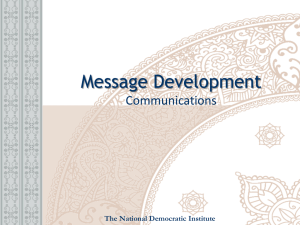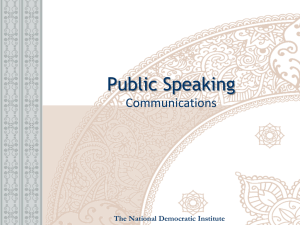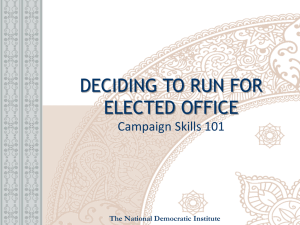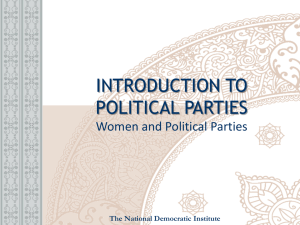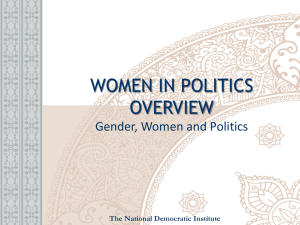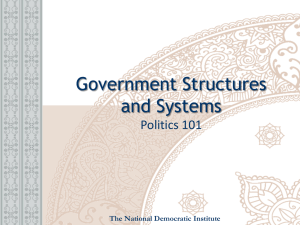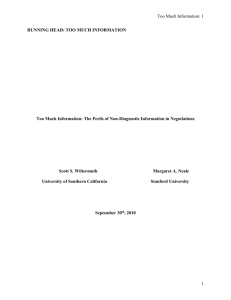empowering women for stronger political parties
advertisement
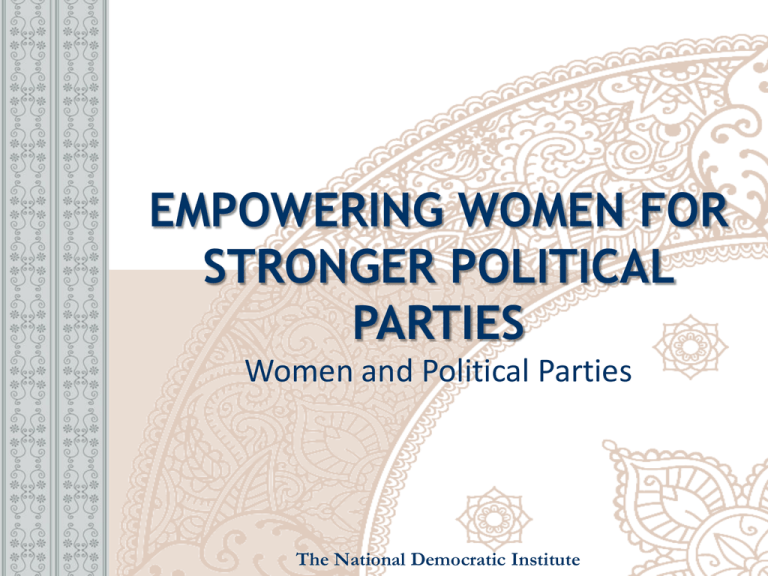
EMPOWERING WOMEN FOR STRONGER POLITICAL PARTIES Women and Political Parties The National Democratic Institute INTRODUCTIONS/ GROUND RULES • Introductions • Ground rules • Ice breaker exercise Photo: NDI OBJECTIVES • To understand the need for and status of women’s participation within parties • To identify barriers for women in political parties • To consider entry points for promoting women’s leadership and participation within political party structures TOPICS • • • • • Why women? Global and national trends Barriers to participation Strategies for empowering women Engaging men Photo: Marie-Eve Bilodeau, NDI KEY TERMS • • • • • Political party Electoral cycle Women’s wing Quota Reserved seat • Parliamentary caucus • Gender • Gender equality • Empowerment WOMEN’S POLITICAL PARTICIPATION: BENEFITS • Higher standards of living • Concerns of marginalized voters represented • Collaborative leadership styles • Work across party lines • Peace building • Better decisions Photo: NDI WHY DO WOMEN NEED PARTIES? • Parties are gateway to political leadership • Parties inform the policy agenda • Yet parties are often the greatest challenge • Women continue to be underrepresented EXERCISE: WOMEN IN POLITICAL PARTIES • True or False? Photo: NDI WHY DO PARTIES NEED WOMEN? • To gain party supporters • To help develop a platform that includes interests of all voters • To win elections! WOMEN IN POLITICS: GLOBAL TRENDS • Women in parliament: 20.3% • Rwanda: 56.3% • 33 parliamentary lower chambers with 30% or more • Presiding officers: 15.1% • 7 countries: no women • 16.7% of ministerial posts • 17 heads of government Photo: Mark Wilson, Getty Images UKRAINE COUNTRY DATA • • • • 63% of Ukrainian voters are women 7.5% of MPs are women 0% of Ukrainian ministers are women 0% of Ukrainian governors are women WOMEN LEADERS Party Women Leaders % of Members MQM Rabta Committee 1. Dr. Nasreen Jalil 2. Ms. Mumtaz Anwar 18% PML Central Cabinet 1. Dr. Hamida Khorho, Senior Vice-President 2. Mrs. Yaqut Jamil-ur-Rehman, Vice-President 3. Begum Mehnaz Rafi, Vice-President 4. Ms. Nilofer Bakhtiar, President, Women’s Wing 14% PML-N Central Cabinet 1. Begum Tehmina Daultana, Vice-President 2. Begum Ishrat Ashraf 3. Ms. Najma Hameed 4% PPP Central Executive Committee 1. Mohtarma Benazir Bhutto, Chairperson 2. Begum Nusrat Bhutto Rahbar 5% UKRAINE TODAY Photo: Sergei Supinsky, AFP/Getty Images UKRAINE: FUTURE? • • • • 30% of MPs are women 30% of governors are women 30% provincial councilors are women 50% local elected officials are women EXERCISE Women’s political participation: identifying helping and hindering forces Image: Inter-parliamentary Union OBSTACLES TO WOMEN’S POLITICAL PARTICIPATION • • • • Photo: NDI Legal Economic Educational Social/cultural/ religious OBSTACLES TO WOMEN’S POLITICAL PARTICIPATION • • • • • Time Space Physical security Lack of confidence Political parties EXERCISE Who does what within the party? Photo: Amy Hamelin, NDI THE ELECTORAL CYCLE INTERNAL PARTY ORGANIZATION • Revise legal framework • Ensure participation in decision-making • Set targets for participation in conventions • Establish/strengthen women’s wings • Mainstream gender in policy development INTERNAL PARTY ORGANIZATION EXAMPLES Australia: Labor Party adopted quotas guaranteeing women’s participation in governing boards. Serbia: G17 Plus women’s wing is recognized in the party bylaws. PRE-ELECTORAL PERIOD Candidate Recruitment and Nomination Stages ELIGIBLES Women 50% of eligible candidates ASPIRANTS Fewer women NOMINEES even fewer women 19% women ELECTED 81% men CANDIDATE RECRUITMENT AND NOMINATION • Key Issues • Quotas o Candidate Quotas o Reserved Seats o Placement and Enforcement Quotas May Be: Voluntary – adopted by parties Legislated – legally required CANDIDATE RECRUITMENT AND NOMINATION STRATEGIES • Party support for quotas • Guidelines for candidate recruitment • Implementation and placement in winnable positions Photo: Amy Hamelin, NDI CANDIDATE RECRUITMENT AND NOMINATION STRATEGIES • • • • Work with CSOs to monitor compliance Cultivate strategic alliances with men Expand the pool of viable candidates Encourage sharing of experiences FUNDING OF PARTIES AND ELECTION CAMPAIGNS • Key Issue: Raising funds to win the nomination and finance campaign • More challenging for women • Lower economic status • Limited fundraising experience and networks Image: www.pixababy.com FUNDING OF PARTIES AND ELECTION CAMPAIGNS • • • • Establish fundraising networks Establish internal party fund Provide subsidies to women Limit nomination and campaign expenditures FUNDING OF PARTIES AND ELECTION CAMPAIGNS • Public funding of parties • Funds for training women • Gender responsive budgeting Image: www.pixababy.com EXAMPLE: EMILY’S LIST • American organization • Seeks to elect Democratic women • 1985: 25 women raised $350,000 • 2010: 700,000 members raised $82 million • Provides funding and training Photo: www.emilyslist.org ELECTORAL PERIOD • Key Issues – Access to funding and media – Capacity building for women – Targeting women voters – Articulating positions on gender ELECTORAL PERIOD STRATEGIES • Train and mentor women candidates • Ensure women’s visibility • Identify and disseminate positions on priority issues for women Photo: NDI ELECTORAL PERIOD STRATEGIES •Gender sensitive electoral monitoring •Gender sensitive voter information Photo: Megan Doherty, NDI POST-ELECTORAL PERIOD Gender Responsive Governance • Formulate policy • Set governance priorities • Address the concerns of women Photo: NDI GENDER RESPONSIVE GOVERNANCE STRATEGIES • Undertake a gender equality assessment • Provide training to newly elected members GENDER RESPONSIVE GOVERNANCE STRATEGIES • Promote gendersensitive reforms in parliament • Ensure gender mainstreaming in party policy • Retain women and give them access to vacancies Photo: AFP/Getty Images GENDER RESPONSIVE GOVERNANCE STRATEGIES • Support women’s cross-party networks and caucuses • Form strategic partnerships with CSOs • Sensitize party members and work with men EXERCISE: POLITICAL PARTY ASSESSMENT Photo: NDI EXAMPLE: BURKINA FASO • • • • Women’s mobilization Candidate quotas Partnership with men Gender neutral quota language Burkina Faso At a Glance: National Assembly: 127 members (20 women/ 16%) Electoral System: Proportional Representation EXERCISE: ENGAGING MEN ROLE PLAY Photo: NDI EXERCISE: PRIORITIZING RECOMMENDATIONS AND DEVELOPING ACTION PLANS Photo: NDI PUBLIC OPINION RESEARCH Ukraine (2010) • Do you think that higher female representation in local councils is needed? 47% of respondent said yes 25% said no • Is the gender of a candidate important? 59% do not care NDI RESOURCES • Empowering Women for Stronger Political Parties • Win with Women Global Action Plan • iKNOW Politics: www.iknowpolitics.org EMPOWERING WOMEN FOR STRONGER PARTIES REVIEW • Link between women’s participation and good governance • Women’s participation benefits parties • Challenges can be addressed throughout the electoral cycle • Contextualized approaches Photo: NDI
